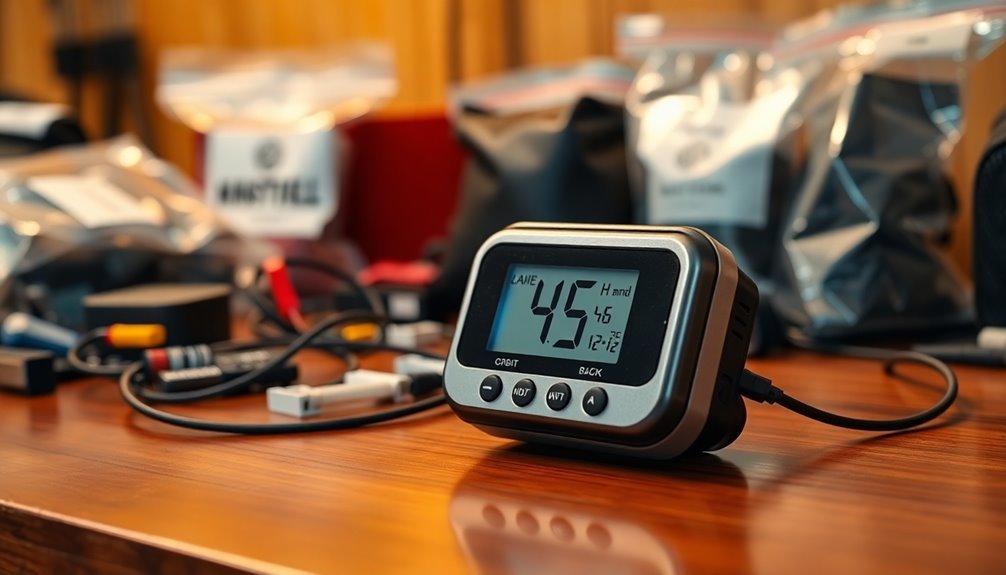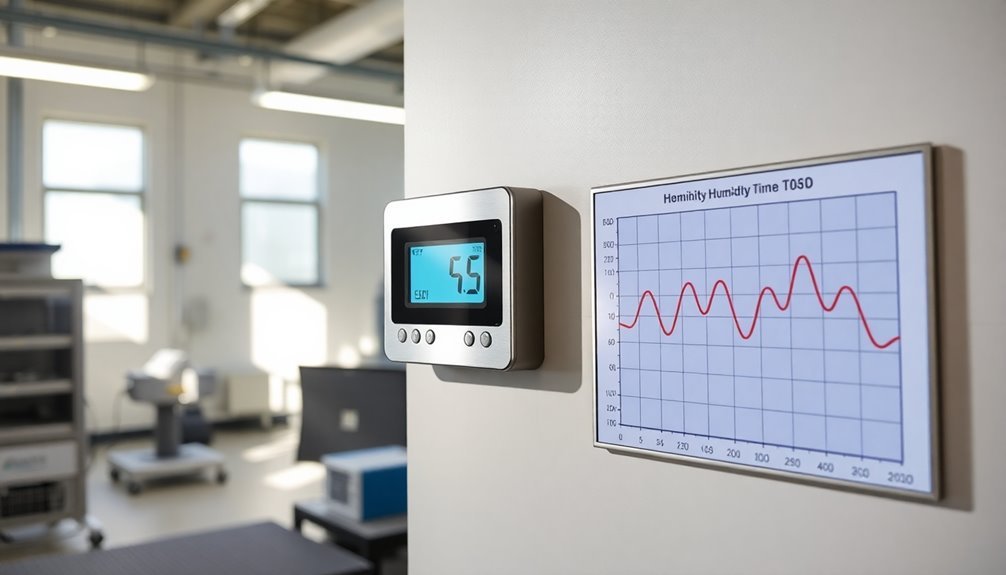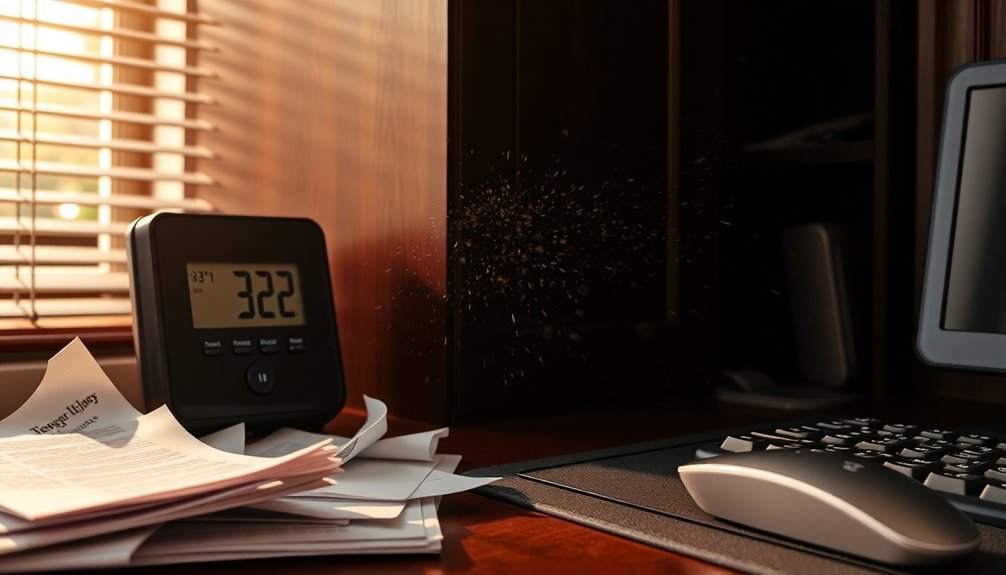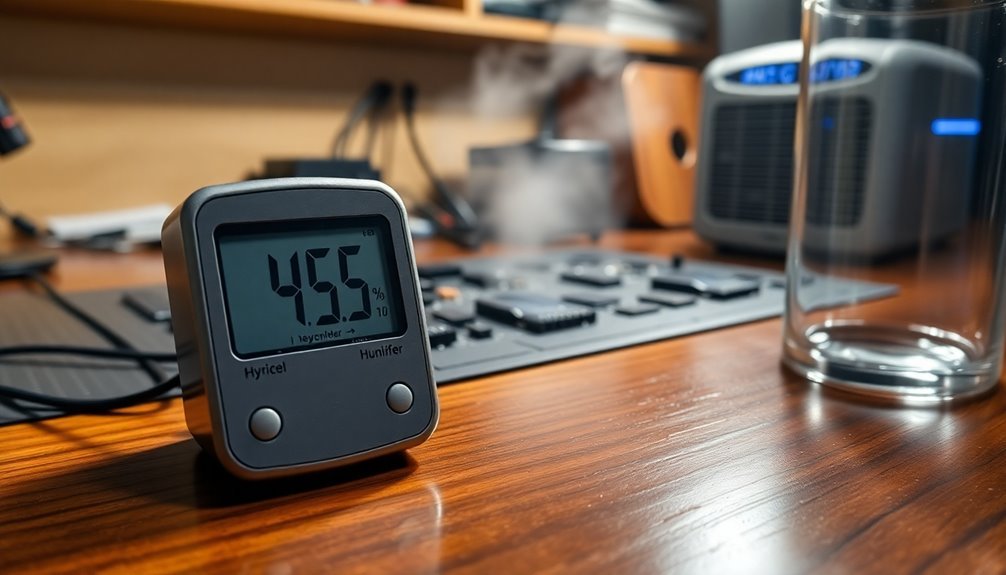Select monitoring devices that measure both humidity and static electricity levels simultaneously, and position them centrally away from walls and heat sources. You'll want to track daily humidity patterns using data loggers while maintaining levels above 55% RH to prevent static buildup. Keep your equipment calibrated and regularly maintained for accurate readings. Don't forget to address problem areas first by identifying zones where machines generate heat and friction. By following these essential monitoring practices, you'll discover the key strategies for creating a static-free environment that protects your sensitive operations.
Choose the Right Monitoring Device

Three critical factors come into play when selecting a humidity monitoring device for static control: sensor capabilities, device features, and placement considerations.
When evaluating sensor capabilities, you'll want to focus on devices that offer multi-parameter monitoring, measuring both humidity and static electricity simultaneously. Look for high-precision electronic hygrometers that cover a broad range from 0% to 100% RH and account for temperature variations. Your device should also calculate dew points to prevent condensation issues. Maintaining humidity levels above 40% RH will help dissipate static charges naturally.
For device features, prioritize solutions with detailed data analysis capabilities that help you understand static electricity patterns. You can choose between inline and handheld options based on your specific needs.
Consider devices with low energy consumption for continuous operation, and make sure they include reverse-osmosis filtration to prevent mineral buildup.
Proper placement is vital for accurate readings. You'll need to position your device away from walls, windows, and heat sources. Make sure there's adequate airflow around the sensor and protect it from contaminants like dust and corrosive agents.
For best performance, operate the device within its recommended ranges and account for hysteresis effects that might impact accuracy.
Position Sensors for Best Results
Strategic sensor positioning can make or break your humidity monitoring system's effectiveness for static control. When placing your sensors, you'll need to find central locations away from walls and obstructions to guarantee accurate readings.
Don't position them near heating vents or in direct sunlight, as these can distort your measurements and compromise your static control efforts.
The system's minute-by-minute updates provide continuous insight into your environment's humidity levels. Consider these critical positioning factors for peak performance:
- Mount sensors vertically and securely to maintain stable readings and prevent disruption from movement or vibration
- Keep sensors away from chemical vapors, direct moisture, and areas prone to flooding that could damage the equipment
- Guarantee adequate airflow around sensors while avoiding drafty areas that might cause rapid humidity fluctuations
You'll need to regularly calibrate and maintain your sensors to keep them functioning accurately. Clean them according to manufacturer guidelines, check for obstructions or debris, and keep firmware updated.
For basement monitoring, position sensors closer to the floor where humidity levels are typically highest. Remember to protect your sensors from temperature extremes and guarantee they're operating within their specified range for reliable static control monitoring.
Track Daily Humidity Patterns

Understanding daily humidity patterns requires consistent monitoring of both relative humidity and dew point levels throughout each 24-hour cycle. You'll notice that relative humidity peaks in the early morning when temperatures are coolest and drops to its lowest point during the afternoon's peak temperatures, even if the actual moisture content (dew point) remains constant.
To track these patterns effectively, you'll need reliable measurement tools. You can use hygrometers for continuous RH readings, psychrometers for precise measurements, or data loggers to record both temperature and humidity at specific intervals. Regular maintenance of these devices is crucial since they can be expensive to replace.
When collecting data, verify your instruments are properly calibrated and strategically placed for accurate readings.
You should consider seasonal variations in your monitoring strategy. During summer months, you'll typically encounter higher dew points and relative humidity levels, particularly in regions like the Ohio Valley where dew points commonly range from mid-60s to mid-70s. Winter months bring lower values for both measurements.
For thorough analysis, you'll want to collect at least a year's worth of data. Use temperature-compensated sensors in your data loggers to maintain accuracy across varying conditions, and regularly analyze your readings to identify patterns and extremes.
Maintain Optimal Moisture Levels
Once you've established reliable tracking of daily humidity patterns, maintaining ideal moisture levels becomes your next priority. To effectively prevent static electricity, you'll need to keep humidity levels above 55% RH in both residential and industrial environments. Using humidifiers and evaporative systems can help you achieve and maintain these ideal conditions consistently.
For the most effective moisture control, consider implementing these essential measures:
- Install humidifiers strategically throughout your space, focusing on areas with heat-generating equipment that can create dry air pockets.
- Monitor humidity levels using humidistats and adjust settings accordingly to maintain the 55% RH threshold.
- Perform regular maintenance checks on your humidification systems and inspect for any leaks that could affect moisture levels.
Consider opening windows and doors when outdoor conditions are dry to help with natural air exchange. In industrial settings, you'll want to pay special attention to both room-wide and localized humidity control. Direct room humidifiers work well for large spaces, while atomizing nozzles can address specific problem areas.
If you're managing a manufacturing or printing facility, maintaining proper moisture levels isn't just about comfort – it's vital for preventing static-related damage to equipment and ensuring product quality.
Address Problem Areas First

Successful static prevention starts by identifying and addressing key problem zones in your facility. You'll need to focus on areas where machines generate heat, as these can create localized dry air pockets with humidity levels falling below 45%RH.
Pay particular attention to equipment that produces friction and heat, as these are prime locations for static build-up. Using an IR temp gun to measure equipment surface temperatures can help identify potential trouble spots.
When you've identified your problem areas, implement targeted humidification solutions. You can mount atomizing nozzles in ceiling spaces or install direct room humidifiers for larger environments.
For heat-generating machines, consider individual nozzles to prevent dry air pockets from forming. These localized spray systems are especially effective in industrial settings like packaging, printing, textiles, and electronics manufacturing.
Monitor these areas regularly to verify your humidification efforts are working. You'll want to maintain humidity levels above 55%RH for ideal static prevention, though levels between 40% and 60%RH can still help reduce static build-up.
Keep tracking humidity levels near equipment and in zones with high static activity, and adjust your humidification strategy based on the monitoring data you collect.
Frequently Asked Questions
Can High Humidity Levels Damage Electronic Devices in My Home?
Yes, high humidity can seriously damage your electronic devices through moisture infiltration, causing short circuits and corrosion. You'll want to keep humidity between 30-50% to protect your valuable electronics from harm.
How Often Should I Calibrate My Humidity Monitoring Devices?
You should calibrate your humidity monitors annually for general use. If you're in high-humidity areas or using them for critical purposes, calibrate every 3-6 months. Check manufacturer's guidelines for specific recommendations.
Will Using a Humidifier Increase My Energy Bills Significantly?
Your energy bills won't increase dramatically if you use a typical humidifier. With average consumption of 35 watts per hour, it's similar to running a light bulb, costing just a few dollars monthly.
Does Outdoor Humidity Affect Indoor Static Electricity Levels?
Yes, outdoor humidity directly affects your indoor static electricity levels. When it's dry outside, you'll notice more static inside. Low outdoor humidity means less moisture enters your home, leading to increased static buildup.
Should Humidity Levels Be Adjusted Differently During Day and Night Periods?
You'll need to adjust humidity levels differently between day and night. During daytime, maintain 30-50% for normal activities, while at night you can let it drop slightly since there's less movement and static generation.
In Summary
You'll get the best results from your humidity monitoring efforts by following these key steps consistently. Choose appropriate devices, place sensors strategically, monitor daily patterns, maintain target moisture levels, and prioritize problem zones. When you're proactive about managing humidity levels, you'll effectively reduce static buildup and protect your sensitive equipment and materials from damage. Start implementing these practices today.





Leave a Reply